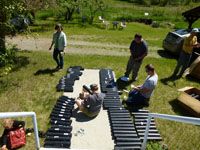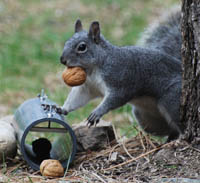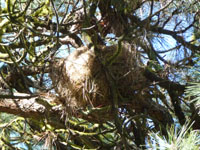Western Gray Squirrel Videos
Experiment to find the optimum tube size
Hannah Edwards, PBI's 2011 conservation science intern, worked on an experiment to compare different lengths and widths of sampling tubes. We suspected that longer tubes may hamper access to the bait, stimulating squirrels to gnaw the tubes. Initial results from several experimental set-ups seem to bear this out, but they haven't answered the converse question: If long tubes don't perform as well, do shorter tubes perform better?
We set up an experiment using a remote camera at one of the experimental tube stations. The video we got was nothing short of amazing.
| The video documents the process of a western gray squirrel exploring the four-plex setup. The exterior nuts are searched for, found and eaten and one of the interior nuts is then removed and eaten. |
| A western gray squirrel looks around for danger and then explores and lifts the tubes, before finally going into one. You can also see it dislodge the sticky tape, which falls out. |
| A western gray squirrel gnaws on one of the tubes. |
More information about the western gray squirrel project is available here:
- Western gray squirrel background information
- Forms for volunteer sampling
- Western gray squirrel volunteer information
This is a partnership project with Washington Dept of Fish and Wildlife.
Copyright © Pacific Biodiversity Institute
PO Box 298, 517 Lufkin Lane
Winthrop, WA 98862 509-996-2490



